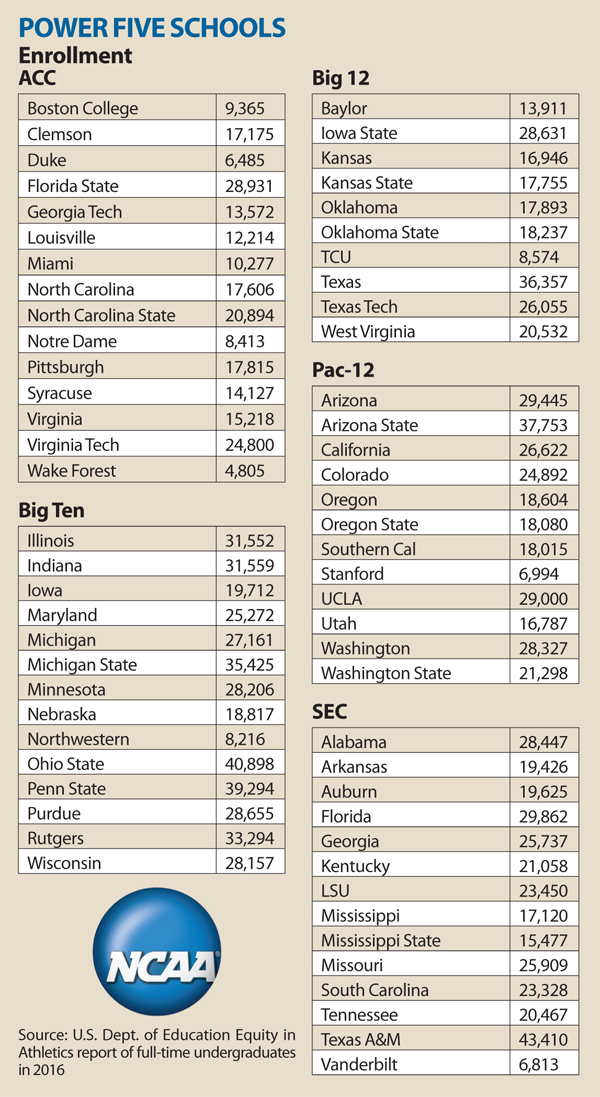A half-dozen of Wake Forest University’s most influential and well-heeled donors sat in an Athens, Ga., restaurant contemplating the Demon Deacons’ football future.
Earlier that day four years ago, they had toured Georgia’s impressive athletic facilities. It was an eye-popping reminder of just how far the Deacons’ own facilities trailed a member of college football’s elite. It seemed like Wake Forest didn’t belong in the same division as Georgia, at least based on facilities.
Dining on steak and sipping red wine, the Deacon donors asked: Were they going to be satisfied being known as the high-achieving academic school that wins an ACC football championship once a generation, or were they willing to spend the money to help tiny Wake Forest — the school with the smallest undergraduate enrollment in the power five at 4,805 — look and act like a program competing at the highest levels?
Ben Sutton, the Wake Forest trustee and former head of IMG College, put it in simpler terms.
“Do we want to get our ass kicked or do we want to win?” Sutton said over dinner.
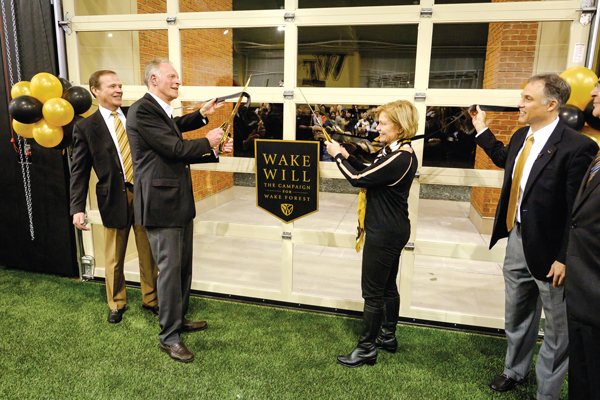 |
Bob McCreary and AD Ron Wellman open the $21 million McCreary Field House,
Photo by: WAKE FOREST |
Sutton was inspired by T. Boone Pickens, the Oklahoma State donor who financially changed the course of the Cowboys’ football program with a $165 million gift in 2005. Pickens, at the time, said he was tired of watching his school lose.
Sutton, who founded ISP Sports in 1992 before selling it to IMG seven years ago, wasn’t prepared to write a check that big, but he did think the Wake Forest donors he brought together could collectively pump life into Demon Deacon football.
Some four years later, Wake’s donors, including the ones who visited Georgia that day, have responded to the challenge. Powered by nearly $200 million in donations, Wake Forest has transformed its facilities for football, and just about every other sport on the cozy 340-acre campus, making the Deacons one of the best-kept secrets in the power five.
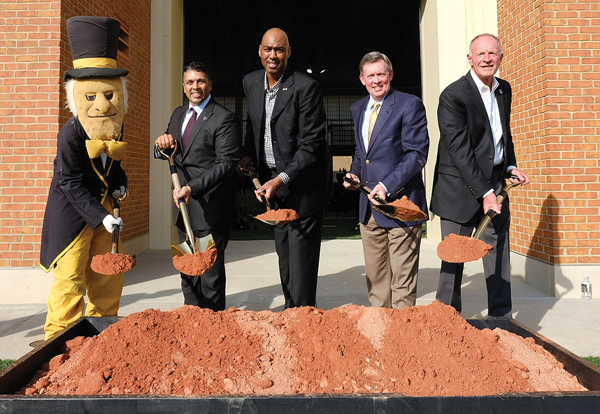 |
Ben Sutton breaks ground on the $40 million Sutton Sports Performance Center.
Photo by: WAKE FOREST |
Sutton, who has traveled to most of the 65 schools that make up the power five because of his former job at IMG College, said he wouldn’t trade Wake’s facilities now for any in the SEC or ACC. Never before could a Wake fan make such a claim.
The linchpins are a $40 million Sutton Sports Performance Center, a four-level, 87,000-square-foot facility set to open next year, and the $21 million McCreary Field House, an indoor practice building that the Deacons call the finest in the country.
Outside of football, a $12 million basketball player development center is in the works for 2018, and a $14 million baseball player development addition opened earlier this year. That doesn’t include millions more for volleyball, field hockey, men’s and women’s soccer, and men’s and women’s golf, which enjoy an 18-acre practice area right on campus.
The newest buildings, minus baseball, will eventually connect, providing the school with an imposing series of athletic structures on the east side of campus. In true Wake Forest fashion, they won’t be the largest in the nation, but they will be among the finest.
“A lot of schools have great facilities, but not right in the middle of campus,” said Ron Wellman, Wake’s longtime athletic director.
Wake’s commitment to facilities, like most schools, reflects how the arms race is driving the building boom in college athletics, especially football. Facilities show recruits a level of commitment, coaches and administrators like to say.
But no one outside of Winston-Salem, N.C., would expect to find facilities that nice at Wake Forest, which has neither the tradition nor pedigree in football to be in a discussion about the finest facilities in the country. The Deacons are trying to change that.
“It just didn’t feel like football was that important here before,” Wake coach Dave Clawson said. “Facilities reflect commitment, and our facilities were not in line with the schools we compete against. Now they are.
“You see all the new buildings on campus and it shows that Wake Forest wants to be great at everything, not just a handful of things.”
There’s certainly no guarantee that they’ll start winning football championships any time soon — Wake is still known as a golf school — but there is a sense that the Deacons’ strength and conditioning, nutrition kitchens, physical therapy, meeting spaces and coaches’ offices can hold their own against other football powers.
 |
An improved home for men’s and women’s golf.
Photo by: WAKE FOREST |
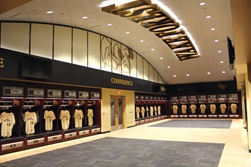 |
The new $14 million baseball clubhouse.
Photo by: WAKE FOREST |
“Facilities here are now a source of pride,” Wellman said. “We use them to brand our program.”
But first, Wake Forest, a school with two ACC football championships in the 64 years since the conference formed, had to ask: Why not us?
Sutton’s challenge to his fellow donors that night in Athens proved “to be a tipping point,” said David Couch, a former Wake baseball player and donor who was at the table that night. “Those who already gave, gave more. And those who had not given, they started to give.”
Sutton’s strategy was to take 10 to 12 of Wake’s best donors on visits to schools like Texas A&M, Texas, Baylor, TCU, Alabama and Georgia, so they could see how big-time programs operate and what kind of investment would be required to play with the best.
The trip to TCU was especially helpful because the Fort Worth school shares a similar profile with Wake — a small private school trying to prove that bigger isn’t always better.
 |
Sutton took a small group of alums around the country to show them what the Deacons needed.
Photo by: WAKE FOREST |
“We’re daring to dream that we can compete and win at the highest levels,” said TCU AD Chris Del Conte, who met with Wake’s traveling party. “We’re not a big public school, so let’s focus on our strengths as a smaller school, like class size and individual attention. … We’re not going to have a 100,000-seat stadium, but let’s have the nicest 45,000-seat stadium in the country.”
How The Deacs Stack Up
The largest and smallest enrollments among power five conferences
Del Conte also shared how TCU raised $105 million from six key donors who kick-started the fundraising for the football stadium’s $160 million renovation. In nearly a decade as AD, Del Conte has raised $340 million for facilities without a penny of debt. Wake Forest, likewise, has completed its projects without any long-term debt.
The median debt for schools in the power five ranges from $5 million to $10 million annually.
“Without the debt, you can take all of that conference revenue and re-invest in your people and facilities to compete at the highest level,” Del Conte said. “You’re not taking huge chunks of money out just to run the enterprise.”
After visiting the other schools, seven Wake donors contributed between $5 million and $40 million, while another half-dozen wrote checks ranging from $1 million to $5 million.
“We had to get to a point,” Sutton said, “where we decided ‘Small is not an excuse.’”
But there remain obstacles — a small enrollment means a small alumni base. Wake’s living alumni numbers 70,000, and just 27,000 of them live in North Carolina.
By comparison, ACC foe North Carolina has more than 300,000 living alumni and half live in-state. Duke, like Wake, a small private school, has 167,000 living alumni.
“You’ve got to raise money from a smaller pool, yes, but we’ve been fortunate to have a very committed group,” Sutton said.
Wake Forest, understanding that it is recruiting a different athlete than Clemson or Florida State, also has themed its facilities around player performance and development. Most players going to Wake plan on redshirting as a freshman and staying five years.
“We’re not for everybody,” Clawson said. “Young men who aren’t serious about being a student and want to find an easy major and get to the NFL after three years, we’re not for them. But that’s what distinguishes Wake Forest.”
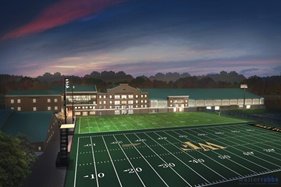 |
The new football practice facility.
Photo by: WAKE FOREST |
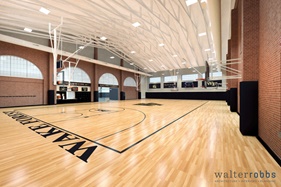 |
The new basketball development center.
Photo by: WAKE FOREST |
The emphasis on player development permeates other sports, like baseball. The Deacons earlier this year opened the first phase of a $14 million clubhouse behind Couch Ballpark that eventually will house a state-of-the-art pitching laboratory. Baseball coach Tom Walter worked with Wake’s assistant coaches, team doctors and a biomechanist from the school’s hospital to create the lab, which will use 18 high-speed cameras to capture a pitcher’s every move.
“Some programs don’t need to develop players,” Walter said. “They’ve got three or four really good players at every position. At Wake, we’re a little different. We don’t have that luxury. We’ve got to make sure each guy is the best version of himself.”
The facility carousel never stops. A new center-hung video board will be the first phase of a renovation to Lawrence Joel Coliseum, and the new Shah basketball complex should be ready for the 2018-19 season.
More expensive projects will follow — that’s just how the game is played at the power five level. And every school has to decide: Do we want to get our ass kicked or do we want to win?
